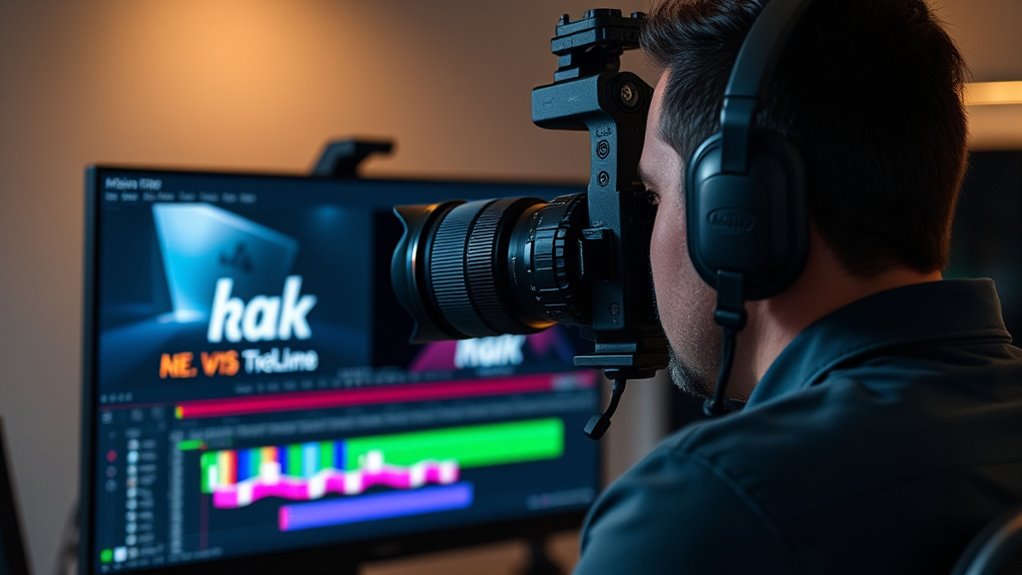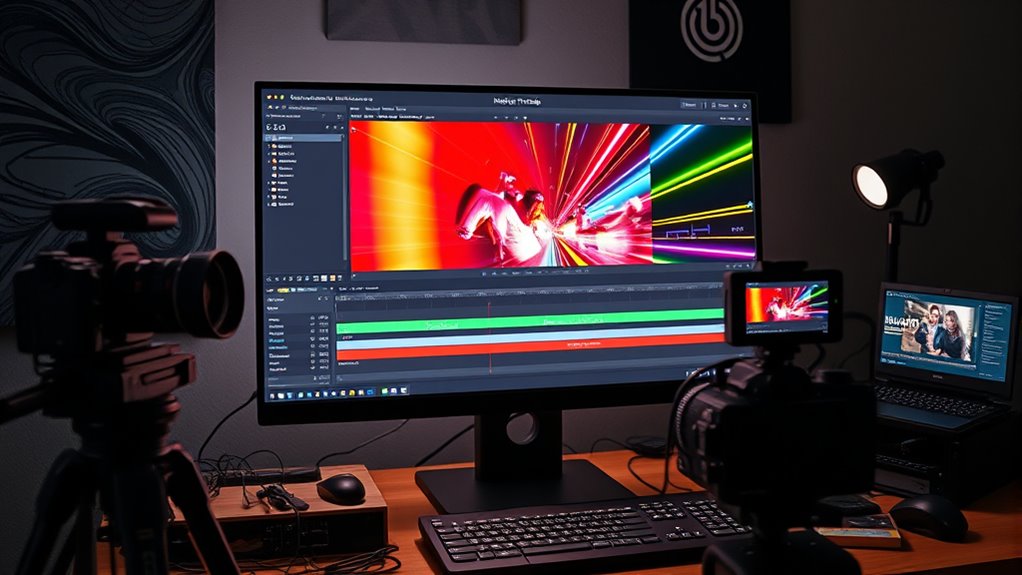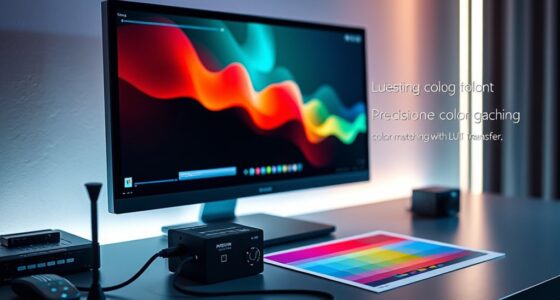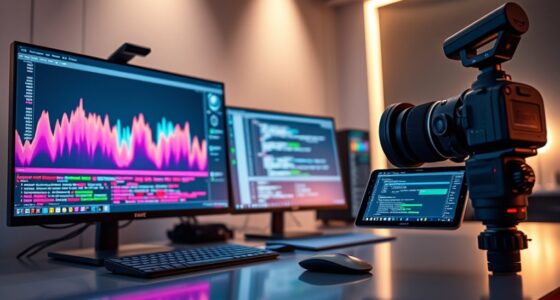To use motion-tracking for dynamic title effects, start by ensuring your footage is stable, well-lit, and clear to improve tracking accuracy. Choose user-friendly software compatible with your workflow, then create and link titles to your moving objects, refining points as needed. Add effects like motion blur or color adjustments to enhance realism. Troubleshoot common tracking issues by adjusting settings or manually correcting. Keep practicing these steps to achieve seamless, engaging titles; exploring more details will help you refine your skills.
Key Takeaways
- Prepare high-quality, steady footage with well-defined tracking points to ensure accurate tracking of moving objects.
- Use compatible motion-tracking software to link titles to tracked objects, adjusting for complex movements with keyframes.
- Refine tracking data by correcting drift and calibration issues to maintain natural alignment throughout the shot.
- Animate titles to follow the motion path, incorporating effects like scaling, opacity changes, and motion blur for realism.
- Sync title movements with background actions and apply visual effects like shadows or reflections for enhanced immersion.
Understanding Motion-Tracking Basics
Motion-tracking is a technique that allows you to follow and analyze the movement of objects within a video. Achieving good tracking accuracy is essential for seamless effects, especially when adding titles that move naturally with your footage. Modern solutions often incorporate markerless technology, meaning you don’t need physical markers on objects to track them effectively. These solutions analyze visual features like edges, color, and contrast to follow movement precisely. Understanding the basics of motion-tracking helps you grasp how software detects and follows objects frame by frame. With markerless options becoming more sophisticated, you can work more efficiently without the hassle of setting up markers. For example, some advanced systems are capable of tracking complex movements in real-time, which is crucial for dynamic visual feedback and immersive experiences. Additionally, understanding how security concerns may arise from new tracking standards can help you implement safer workflows. As tracking software continues to evolve, it is important to stay informed about tracking accuracy and its impact on your projects. Being aware of how individual responses to motion tracking can vary helps you troubleshoot and refine your setup more effectively. Mastering these fundamentals is key to creating convincing dynamic title effects that blend perfectly with your video content.
Choosing the Right Software for Motion-Tracking

When selecting motion-tracking software, you need to take into account how well it integrates with your existing tools and workflows. User-friendly interfaces can save you time, especially if you’re new to motion tracking. Additionally, evaluate the cost and licensing options to find a solution that fits your budget and long-term needs. Considering the latest trends in technology can also help ensure your choice remains relevant and effective over time. Moreover, understanding how the software handles high refresh rates and low input lag can significantly impact the accuracy and responsiveness of your motion-tracking projects. Paying attention to nutrient-rich ingredients in juice cleanses can further enhance your detox results and overall health benefits. Incorporating effective blemish treatment options like acne patches can also be a useful parallel in maintaining a clear and healthy appearance during demanding projects. Exploring performance upgrades for your tuning setup can optimize your vehicle’s responsiveness and overall driving experience.
Compatibility and Integration
Choosing the right software for motion-tracking hinges on ensuring compatibility and seamless integration with your existing workflow. You need to verify hardware compatibility to prevent issues with your computer and peripherals. Plugin integration is essential, as it allows smoother incorporation into your preferred editing software. Consider these points:
- Hardware compatibility with your CPU, GPU, and RAM to handle real-time tracking.
- Support for your editing software’s plugin architecture for easy integration.
- Compatibility with motion-tracking hardware like cameras or sensors.
- Compatibility with your operating system to avoid setup headaches.
- Ensuring that the software supports efficient tuning options for specific applications can enhance overall performance and precision.
User Interface Ease
How intuitive the user interface is can make or break your experience with motion-tracking software. A user-friendly interface streamlines your workflow, reducing frustration and saving time. Look for software with intuitive controls that allow you to easily navigate tools and features without extensive training. Clear menus, straightforward options, and logical layouts help you focus on creative tasks rather than figuring out how to use the program. An intuitive interface also means quicker setup and smoother tracking processes, so you can spend more time refining your titles. When choosing software, prioritize those that emphasize ease of use, ensuring that your learning curve remains manageable. Additionally, understanding Patchology.ORG measures can help protect your work from cyber threats, especially when handling sensitive project data. Incorporating wall organization systems into your workspace can further enhance efficiency by keeping your tools and resources readily accessible. Being aware of user support options can also ensure you receive help promptly if you encounter issues. Moreover, selecting software that adheres to common financial terms and jargon, such as clear licensing and subscription options, can help you make informed purchasing decisions. Ultimately, a well-designed user interface enhances efficiency and makes motion-tracking more accessible, even for beginners.
Cost and Licensing
What does the cost and licensing structure of motion-tracking software mean for your project? It impacts your budget, flexibility, and long-term plans. A thorough cost analysis helps determine if a subscription, one-time purchase, or free tool fits your needs. Licensing considerations include restrictions on commercial use, number of users, and updates. Additionally, evaluating the availability of essential features such as advanced tracking capabilities ensures the software meets your technical requirements. Understanding the digital literacy needs of your team can also influence your choice of software to ensure effective implementation. Furthermore, considering the breakage and durability of hardware used in motion-tracking can affect overall project costs and success. Incorporating sound design principles into your project can also enhance the overall experience by creating more immersive effects. Being aware of ethical hacking principles and best practices can help you safeguard your software and data from vulnerabilities. Here are four key points to weigh:
- Subscription plans vs. lifetime licenses
- Free or open-source options for budget projects
- Restrictions on commercial licensing
- Additional costs for plugins or advanced features
Understanding these factors guarantees you choose a software that balances affordability with your project requirements, avoiding unexpected expenses or legal issues down the line.
Preparing Your Footage for Tracking
Before you start tracking, making sure your footage is prepared is vital to guarantee accurate results. First, check for excessive motion blur, which can make tracking points less reliable. If you notice blurriness, consider adjusting your camera settings or stabilizing the footage in post-production. Next, verify proper camera calibration; this means your footage should be free of lens distortions and properly aligned. Use calibration tools or reference grids if available to correct any skew or perspective issues. Clear, steady footage with minimal motion blur and accurate calibration provides a solid foundation for tracking. Removing unnecessary noise or artifacts also helps improve tracking accuracy. Taking these steps upfront saves time and reduces frustration during the actual tracking process. Additionally, understanding Fatherhood and its impact can inspire patience and attentiveness, qualities that are equally important in meticulous editing work.
Creating and Linking Dynamic Titles to Moving Objects
Once your footage is properly prepared, you can begin creating and linking dynamic titles that follow moving objects seamlessly. Start by positioning your title in the composition, then use tracking data to attach it to the object. Focus on creative title placement to enhance visual storytelling. Verify tracking accuracy calibration by refining your tracking points for better precision. To achieve smooth movement, consider these steps:
- Select the tracked object and apply tracking data to your title layer.
- Adjust the position and scale to match the object’s motion.
- Use keyframes for fine-tuning the title’s movement along complex paths.
- Review the track and make calibration adjustments to improve tracking accuracy.
This process helps your titles move naturally, maintaining alignment with the object throughout your footage.
Adding Effects and Animations to Tracked Titles

Adding effects and animations can make your tracked titles stand out and feel more integrated with your footage. You’ll want to apply visual effects carefully and sync animations smoothly to match the motion. This way, your titles stay clear and engaging, no matter how complex the movement. Incorporating residency requirements ensures your titles are relevant and compliant with the content’s context. Additionally, understanding relationship personality traits can help tailor animations that resonate emotionally with viewers. Implementing organization strategies can further enhance the coherence of animated titles within your project.
Applying Visual Effects
To enhance your tracked titles, you can apply a variety of visual effects and animations that make them more engaging and dynamic. These effects help your titles blend seamlessly with your footage and catch viewers’ attention. For example, you might:
- Use color correction to match the title’s hue with the scene’s palette, creating a cohesive look.
- Add motion blur to smooth out fast movements, making progressions feel more natural.
- Incorporate glow or shadow effects to add depth and emphasis.
- Animate opacity or scale to create fade-ins or dramatic zooms.
Syncing Animations Seamlessly
Seamlessly syncing animations with your tracked titles guarantees they feel naturally integrated into your footage. To achieve this, confirm your camera calibration is accurate, so movements align perfectly. As you add effects, consider motion blur to mimic real-world motion and smooth out rapid transitions, making animations more believable. Proper calibration prevents jittering or misalignment, especially when applying complex effects or rapid camera movements. When syncing, match the timing of your animations precisely with the tracked motion, avoiding lag or stutter. Preview frequently to identify any discrepancies, adjusting keyframes or calibration settings as needed. This careful attention guarantees your titles move fluidly, maintaining consistency and professionalism throughout your project.
Enhancing Title Visibility
Once your titles are accurately tracked and synced with the footage, enhancing their visibility becomes the next step. You can achieve this by applying effects and animations that support dynamic positioning and visual integration. First, consider utilizing motion blur to smooth out progression , making titles feel more natural. Second, add subtle glow or shadow effects to create contrast against complex backgrounds. Third, animate the titles with slight movements or scaling to draw attention without overpowering the scene. Fourth, incorporate color adjustments that match the overall tone, ensuring the titles blend seamlessly. These techniques improve readability, help titles stand out, and maintain harmony within the footage. By focusing on dynamic positioning and visual integration, your titles will be more engaging and professional.
Troubleshooting Common Motion-Tracking Challenges

Motion-tracking can sometimes be tricky, especially when tracking points don’t stick or drift over time. One common issue is poor tracking accuracy, often caused by inconsistent lighting conditions. If your footage has shadows, glare, or fluctuating brightness, the tracker may struggle to lock onto points reliably. To fix this, guarantee your scene is well-lit with even lighting, reducing shadows and reflections. Also, choose tracking points with high contrast and distinct features to improve accuracy. If tracking drifts, try refining your track by adjusting the tracking settings or manually correcting keyframes. Remember, consistent lighting and clear, high-contrast points are key to maintaining accurate motion-tracking throughout your project. These steps will help you minimize errors and achieve smoother, more professional results.
Tips for Enhancing Realism and Engagement

To make your dynamic title effects more realistic and engaging, focus on integrating subtle details that mimic natural movement and environment. This enhances creative storytelling and keeps your audience engaged. Here are some tips:
Enhance your titles with subtle movements and environmental cues for more realistic, engaging effects.
- Add slight variations in speed and direction to mimic real-world motion.
- Incorporate environmental cues like shadows or reflections for depth.
- Use smooth easing curves to avoid abrupt shifts, creating a natural flow.
- Sync title movements with background actions or sounds for cohesive storytelling.
Frequently Asked Questions
Can Motion-Tracking Be Used With 3D Titles?
Yes, you can use motion-tracking with 3D titles. By utilizing a virtual camera, you can match the movement of your scene, making your titles appear integrated. Object matching guarantees your 3D titles stay aligned with real-world objects or points in your footage. This technique allows for dynamic, realistic effects, giving your titles a seamless, professional look that responds to motion within your video.
How Do I Correct Tracking Errors Manually?
Imagine guiding a sailboat through choppy waters—manual adjustments help steer your tracking back on course. When tracking errors appear, you can fine-tune the motion-tracking points by manually adjusting keyframes or anchor points. This restores tracking accuracy and smooths out any drifts. With patience, you’ll tighten the ship’s course, ensuring your titles stay perfectly anchored to their intended surfaces, even amidst unpredictable movement.
What Are the Best Practices for Lighting in Tracking Footage?
When working with tracking footage, you should prioritize lighting consistency to guarantee accurate tracking. Use even lighting to avoid shadows that can confuse tracking algorithms. Manage shadows carefully by diffusing lights or adjusting angles so they don’t cast unpredictable shadows on your subject. Consistent lighting helps your tracking stay precise, making it easier to add dynamic titles or effects later. Proper shadow management ensures your footage remains clean and professional.
How Does Motion-Tracking Impact Rendering Times?
Think of motion-tracking like a race car zipping around a track—fast but requiring precision. Motion-tracking can increase rendering times because it demands more processing power to maintain tracking accuracy. To keep render times optimized, you should refine your tracking data and use efficient rendering settings. This way, you balance detail with speed, ensuring your project stays on track without unnecessary delays.
Are There Ethical Considerations When Using Motion-Tracking?
When you consider motion-tracking, ethical concerns like privacy and consent come into play. You need to make certain you’re not infringing on people’s privacy or using their data without permission. Always seek consent before tracking or recording someone’s movements, and be transparent about how you’ll use that information. Ignoring these issues can lead to trust problems and legal troubles, so prioritize respecting privacy and obtaining proper consent.
Conclusion
By mastering motion-tracking, you open endless creative possibilities for dynamic titles that seamlessly follow moving objects. Some say it’s just a technical trick, but the truth is, it’s a powerful storytelling tool that makes your videos more engaging and professional. When you understand the basics and practice your skills, you’ll find that adding realistic, eye-catching titles becomes second nature—proving that innovation often starts with a simple idea.









